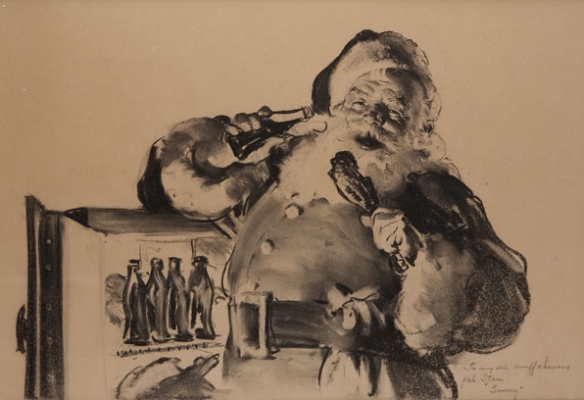Where did Santa come from?
The True History of the Modern Day Santa Claus
While Coca-Cola did not create the legend of Santa Claus completely, it is true that Coca-Cola advertising played a big role in shaping the jolly character we know and love today.
Before 1931, there were many different depictions of Santa Claus around the world including a tall gaunt man and an elf, some even featured Santa Claus in a somewhat frightening manner.
The friendly, warm and grandfather-like image we see of Santa today first appeared in 1931 when Coca-Cola commissioned illustrator Haddon Sundblom to paint Santa Clause for the company’s Christmas adverts. Sundblom’s paintings for Coca-Cola established Santa as a warm, happy character with human features such as rosy cheeks, a white beard, twinkling eyes and laughter lines. Sundblom drew inspiration from an 1822 poem by Clement Clark Moore titled “A Visit from St. Nicholas” also known as “Twas the Night Before Christmas”.
In the article below by The Coca-Cola Company, we can find interesting trivia treasures about our beloved Santa Claus.
The Santa Claus we all know and love – that big, jolly man in the red and white suit with a white beard – didn’t always look the way he now does.
In fact, many people are surprised to learn that prior to 1931, Santa was depicted as everything from a tall gaunt man to a spooky-looking elf. He has donned a bishop’s robe and a Norse huntsman’s animal skin.
In fact, when American cartoonist Thomas Nast drew Santa Claus for Harper’s Weekly in 1862, Santa was a small elf-like figure. Nast continued to draw Santa for 30 years, changing the colour of his jacket from tan to the red he’s known for today.
1. Santa has been featured in Coke Ads since the 1920’s
Coca-Cola began their Christmas advertising in the 1920s, with Santa Claus entering the picture not long after that.
The Coca-Cola Company began its Christmas advertising in the 1920s with shopping-related ads in magazines. The first Santa ads used a strict-looking Claus.
In 1930, artist Fred Mizen painted a department store Santa in a crowd drinking a bottle of Coke. The ad featured the world’s largest soda fountain and was used in print ads that Christmas season.
2. Coca-Cola helped shape the image of Santa
The magical transformation of the Coca-Cola Santa happened in 1931, becoming a man wholesome and kind in appearance.

In 1931 the company began placing Coca-Cola ads in popular magazines. Archie Lee, the advertising executive working with The Coca-Cola Company, wanted the campaign to show a wholesome Santa who was both realistic and symbolic. So Coca-Cola commissioned American illustrator Haddon Sundblom to develop advertising images using Santa Claus — showing Santa himself, not a man dressed as Santa.
For inspiration, Sundblom turned to Clement Clark Moore’s 1822 poem “A Visit From St. Nicholas” (commonly called “‘Twas the Night Before Christmas”). Moore’s description of St. Nick led to an image of a warm, friendly, pleasantly plump and human Santa. (And even though it’s often said that Santa wears a red coat because red is the color of Coca-Cola, Santa appeared in a red coat before Sundblom painted him.)
From 1931 to 1964, Coca-Cola advertising showed Santa delivering toys (and playing with them!), pausing to read a letter and enjoy a Coke, visiting with the children who stayed up to greet him, and raiding the refrigerators at a number of homes.
In the beginning, Sundblom painted the image of Santa using a live model — his friend Lou Prentiss, a retired salesman.

3. The “new Santa” was based on a salesman
In the beginning, Sundblom painted the image of Santa using a live model — his friend Lou Prentiss, a retired salesman. When Prentiss passed away, Sundblom used himself as a model, painting while looking into a mirror. Finally, he began relying on photographs to create the image of St. Nick.
People loved the Coca-Cola Santa images and paid such close attention to them that when anything changed, they sent letters to The Coca-ColaCompany. One year, Santa’s large belt was backwards (perhaps because Sundblom was painting via a mirror). Another year, Santa Claus appeared without a wedding ring, causing fans to write asking what happened to Mrs Claus.
The children who appear with Santa in Sundblom’s paintings were based on Sundblom’s neighbors — two little girls. So he changed one to a boy in his paintings.
The dog in Sundblom’s 1964 Santa Claus painting was actually a grey poodle belonging to the neighborhood florist. But Sundblom wanted the dog to stand out in the holiday scene, so he painted the animal with black fur.
4. Santa Claus got a new friend in 1942
In 1942, Coca-Cola introduced ” Sprite Boy,” a character who appeared with Santa Claus in Coca-Cola advertising throughout the 1940’s and 1950’s. Sprite Boy, who was also created by Sundblom, got his name due to the fact that he was a sprite, or an elf. (It wasn’t until the 1960’s that Coca-Cola introduced the popular beverage Sprite.)
Sundblom’s second painting features a note in which a child, Jimmy, leaves a Coke for Santa instead of cookies.

5. Santa became animated in 2001
In 2001, the artwork from Sundblom’s 1962 painting was the basis for an animated TV commercial starring the Coca-Cola Santa. The ad was created by Academy Award-winning animator, Alexandre Petrov.
Beloved by children and adults alike, Santa Claus has truly made a permanent mark in our world today. From folkloric origins to the modern day interpretation we see today, Santa Claus remains to be an iconic Christmas figure for all.
See more Sunbloom Santa over the years here >